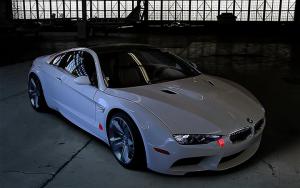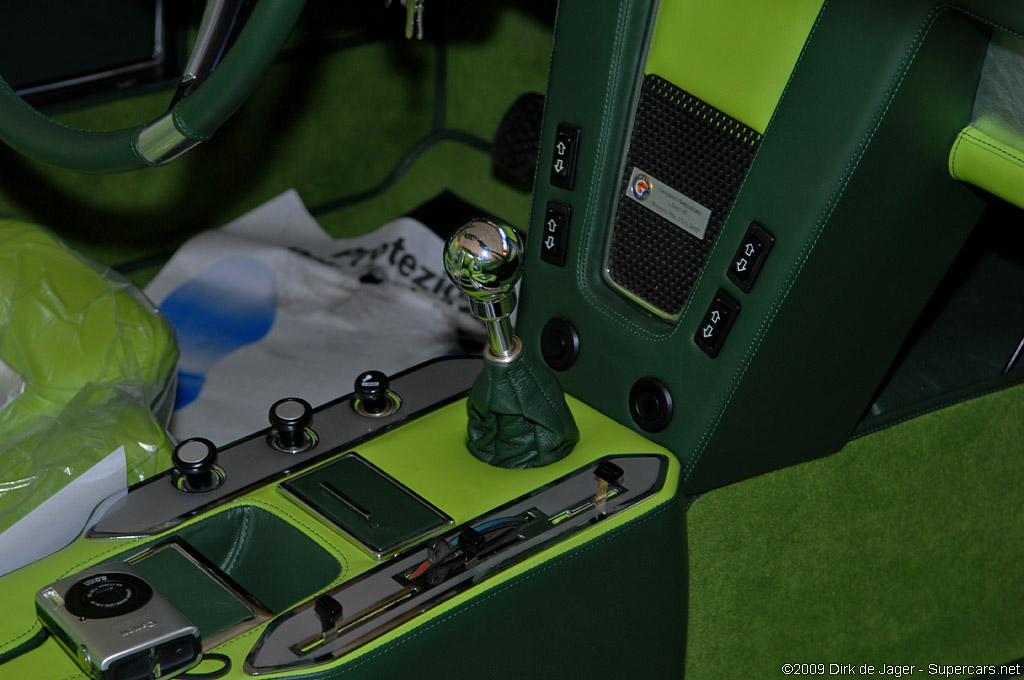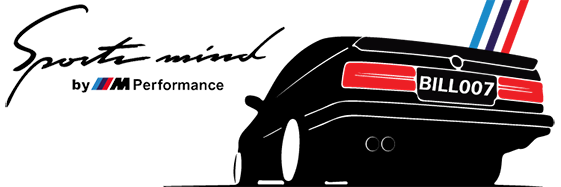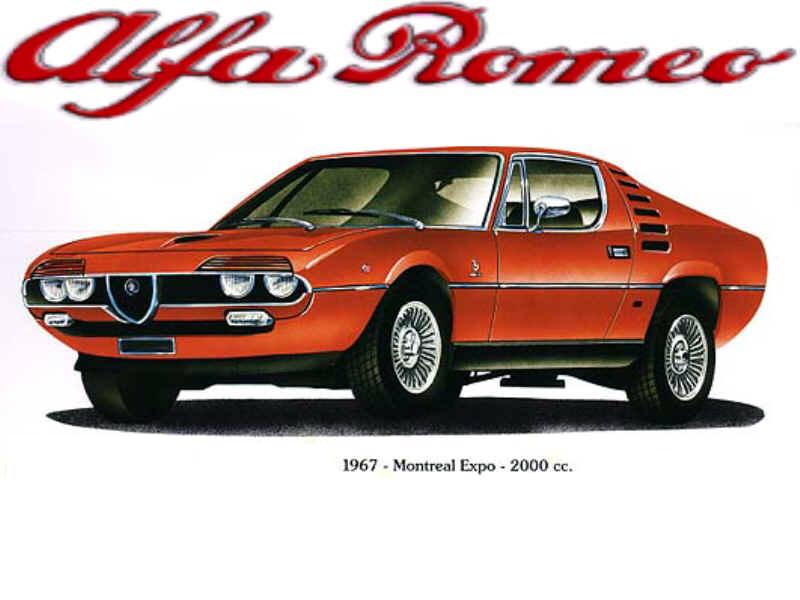Details
Type Concept / Prototype Car
released at 1969 Geneva Motor Show
body stylist Marcello Gandini
coachbuilder Bertone
production 1
engine Inline-6
position Front, Longitudinal
aspiration Natural
valvetrain SOHC, 2 Valves per Cyl
fuel feed 2 Zenith Carburetors
displacement 2788 cc / 170.1 in³
bore 86 mm / 3.4 in
stroke 80 mm / 3.1 in
compression 9.0:1
power 126.8 kw / 170 bhp @ 6000 rpm
specific output 60.98 bhp per litre
bhp/weight 127.82 bhp per tonne
torque 235.9 nm / 174 ft lbs @ 3700 rpm
body / frame Steel BMW 2500 Chassis
driven wheels RWD
f suspension MacPherson Struts
r suspension Semi-Trailing Arms
curb weight 1330 kg / 2933 lbs
wheelbase 2340 mm / 92.1 in
front track 1445 mm / 56.9 in
rear track 1465 mm / 57.7 in
length 4150 mm / 163.4 in
width 1780 mm / 70.1 in
height 1207 mm / 47.5 in
transmission 4-Speed Manual
top speed ~210 kph / 130.41 mph
by Richard Owen
Τη 10ετία του 60Ά τα concept ήταν σαφέστατα λιγότερα από ότι σήμερα ενώ μία άλλη μεγάλη διαφορά εντοπίζονταν στη δυνατότητα να κινούνται σαν κανονικά αυτοκίνητα σε αντίθεση με τα σημερινά τα οποία στις περισσότερες των περιπτώσεων είναι μόνον εκθεσιακά. Αυτό βέβαια γίνονταν προκειμένου οι αυτοκινητοβιομηχανίες μετά την έκθεση του concept στο κοινό να το πουλήσουν και να μη χάσουν τα χρήματά τους. Για αυτόν το λόγο χρησιμοποιούνταν μία βάση από ένα μοντέλο της εποχής στο οποίο κάποια carrozzeria “έφτιαχνε” το κουστούμι.The story about the 1969 BMW 2800 Bertone Spicup.
In 1961 BMW was looking for a replacement for the aging 503 Coupe. They turned to Bertone to produce a classically proportioned coupe body with distinctive BMW styling marks, in particular the kidney grill. The result of the joint effort, the 3200 CS V8, was introduced at the IAA in 1961 and production started in 1962. This established a firm knot between BMW and Nuccio Bertone, who became a personal consultant to BMW. Although having limited commercial success, the 3200 CS' elegant and understated lines were generally highly acclaimed. Production of the 3200 CS lasted to April 1965 and about 600 were made.
Launched three years later, the successor to the 3200 CS was the 2800 CS, which was styled in-house. It was the coupe version of the all new 6 cylinder E3 sedan model. The new engine (available in 2.5 or 2.8 liter displacements) was the pioneer of the straight six engines that power BMWs to this day. The 2800 CS, internally called E9, was basically a combination of the front part of the E3 with the glasshouse of the smaller engined 2000 CS four cylinder coupe. BMW, however, did not forget about Bertone and asked them to create their own version of the 2800 coupe.
Using a 30 cm shortened BMW 2500 chassis as a base, Bertone created the Spicup show car. The name referred to the Spider/Coupe option, offered by a roof consisting of two panels, that could slide into a large size T-bar. The interior was fitted with a cacophony of green, yellow and silver skai upholstery. The front part of the bore a resemblance to the Alfa RomeoMontreal, shown a year earlier. Sadly, the striking car was not very well received at its 1969 Geneva Motor show launch and with no further use for it, BMW decided to sell it.
Its new owner then clocked up over 100,000 km with what was basically a show car. At one point he changed the exterior color to orange and the interior to mainly black. Eventually the car was put off the road, until it reappeared some years ago in The Netherlands in the hands of a collector. He then sold it to a Belgian enthusiast, who has brought it back to its former glory. It required a full re-spray but the interior formed the biggest challenge as matching colours of the original material used were not available anywhere. It was therefore decided to go for all leather trim, whereby the silver parts of the seats were actually hand painted.
The first owner connected the silver engine cover with the hood so that they opened together. During the restoration it was brought back to the original configuration, whereby the cover sits firmly over the engine. The tolerances between hood and cover are about 1 mm, but even starting the engine does not create enough vibration to make the two parts touch.
The car was shown at the 2009 Villa d'Este Concours, where the proud new owner, having literally put the last hand on the restoration the day before the Concours, gave us an opportunity to admire this remarkable motorcar.
Ένα τέτοιο και άκρως ιδιαίτερο concept ήταν το BMW Spicup (Spider/Coupe) που παρουσίασε η Carrozzeria Bertone στο σαλόνι αυτοκινήτου της Γενεύης του 1969 και μάλιστα στο δικό της περίπτερο. Το περίεργο και διόλου ευκαταφρόνητο είναι πως το BMW Spicup κατάφερε να βάλει να εργαστούν μαζί μεγάλα ονόματα του σχεδιασμού όπως ο Giorgetto Giugiaro, ο οποίος εργάζονταν τότε στον Bertone, η Carrozzeria Ghia και ο Marcelo Gandino ο σχεδιαστής μερικών εκ των πλέον σπορ και εξωτικών αυτοκινήτων όπως η Alfa Romeo Montreal και αρκετές Lamborghini.
Το αποτέλεσμα που βλέπετε στις φωτογραφίες είναι άκρως ιδιαίτερο. Ίσως το εμπρόσθιο μέρος με τα κρυμμένα φωτιστικά σώματα να σας θυμίσει την Montreal αλλά σίγουρα έχουμε να κάνουμε ένα πολύ ενδιαφέρον σχήμα. Μάλιστα η αφαιρούμενη οροφή εφαρμόστηκε αργότερα στο Fiat X1/9. Βάση του BMW Spicup αποτέλεσε η BMW 2000CS από την οποία δανείστηκε και το straight-six μοτέρ των 2.5lt.
Το BMW Spicup πουλήθηκε μετά τις εκθέσεις που εμφανίστηκε ως έκθεμα. Τη 10ετία του 70Ά αγοράστηκε από έναν Ολλανδό ο οποίος αφού το έβαψε πορτοκαλί του είχε μεγάλη αγάπη και κυκλοφορούσε με αυτό κάθε ημέρα παρά τα όποια προβλήματα στεγανότητας της οροφής. Για αυτόν το λόγο το αυτοκίνητο έχει στο χιλιομετρητή του περισσότερα από 100.000km, τα οποία το κάνουν ίσως το πιο πολυταξιδεμένο concept παγκοσμίως.
Τα προηγούμενα χρόνια το αυτοκίνητο επανήλθε στην αρχική του κατάσταση μετά από γενική ανακατασκευή που πραγματοποίησε η Carozzeria Granturismo και εμφανίστηκε για κάποιους μήνες στο μουσείο της BMW στο Μόναχο. Εκεί, πρόσφατα δημοπρατήθηκε από τον οίκο Bonhams με το νέο ιδιοκτήτη να ξοδεύει το ποσό των 460.000¤.















 Απάντηση με παράθεση
Απάντηση με παράθεση











 για το όμορφο thread! 5 stars rated already!
για το όμορφο thread! 5 stars rated already! 




